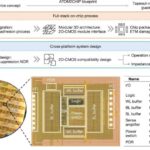Rheumatoid arthritis is one of the most disabling autoimmune conditions, affecting about 1.3 million adults in the U.S.1 It’s not just about painful, swollen joints — this disease steadily erodes cartilage and bone, often leaving people with deformity, disability, and a higher risk of heart disease.
The symptoms — stiffness, fatigue, and tender joints — are what most people notice first, but the real story begins much earlier, deep inside your immune system. What makes this condition so concerning is how it accelerates aging on the cellular level. Long before joint damage becomes obvious, the immune system shows signs of wear and tear usually seen decades later in life.
Instead of working like a youthful defense system, it behaves like one that’s been prematurely aged — producing fewer fresh immune cells, failing to repair DNA properly, and accumulating worn-out cells that spread inflammation. This discovery reframes rheumatoid arthritis from being just an inflammatory joint disease to something larger: a disorder of accelerated immune aging.
That perspective explains why the disease is linked with other aging-related problems, including heart disease and osteoporosis, and why some people progress faster depending on their genetic makeup. Understanding that immune aging comes first means that targeting the aging of your immune system — rather than just calming inflammation after the fact — opens new doors for earlier diagnosis and treatment.
Early Immune Aging Shows Up Before Rheumatoid Arthritis Is Diagnosed
Research published in eBioMedicine set out to examine whether people already show signs of an “old” immune system even before rheumatoid arthritis is officially diagnosed.2 To answer this, researchers recruited 224 participants: some were healthy controls, others had early joint pain, some had undifferentiated arthritis — joint issues not yet classified as rheumatoid arthritis — and others had newly diagnosed or established rheumatoid arthritis.
• People with unexplained joint pain already showed immune changes — Those with early joint pain and undifferentiated arthritis had fewer “naïve” T cells, which are fresh immune cells that normally leave your thymus — the small gland in your chest that makes these defenders — ready to fight new infections. They also had fewer “recent thymic emigrants,” meaning their thymus gland was already slowing down production of these fresh cells, a process usually tied to old age.
• Advanced immune aging showed up only after RA was established — Other aging traits, such as higher levels of inflammatory cells, more regulatory T cells, and an accumulation of “senescent-like” T cells, were only seen in people who already had confirmed RA. These senescent cells are immune cells that stop dividing, release inflammatory substances, and act like they’re stuck in old age, driving chronic inflammation.
• Inflammatory markers were elevated even before arthritis set in — People with early joint pain had higher blood levels of inflammatory molecules compared to healthy controls. These markers increased even more as rheumatoid arthritis developed, showing that inflammation builds long before the disease fully takes hold.
• The immune aging score was higher in pre-disease groups — Researchers created a score to measure how old someone’s immune system looks compared to their actual age. Patients with undifferentiated arthritis already had higher scores than healthy controls, and the scores were even higher in early and established rheumatoid arthritis. This suggests your immune system could be older than you are on paper, raising the risk of rheumatoid arthritis.
• Faulty cleanup systems and stressed genes push immune cells into early aging — The study showed that reduced autophagy — the process cells use to clean out waste and damaged parts — was already present in early disease stages. Lower autophagy contributes to a buildup of malfunctioning cells and more inflammation. At the same time, genes tied to metabolic stress and cell aging were altered, driving immune cells into a prematurely aged state.
If immune aging is happening years before RA symptoms fully develop, that means you could target aging processes themselves — like supporting autophagy or removing senescent cells — to slow or prevent rheumatoid arthritis progression. Compounds such as spermidine and senolytics — treatments designed to clear out worn-out “zombie” cells that no longer function properly but still spread inflammation — are being studied for exactly this purpose.
Rheumatoid Arthritis Accelerates Immune System Decline by Decades
A review published in Rheumatic Disease Clinics of North America similarly outlined how rheumatoid arthritis is not simply a condition of inflamed joints — it’s also tied to rapid immune aging.3 The authors explained that people with rheumatoid arthritis often show immune system changes that normally don’t appear until 20 years later in life, suggesting the disease is tied to premature aging of the body’s defenses.
• The immune system of rheumatoid arthritis patients looked decades older than healthy peers — Patients in their 40s and 50s with RA had immune systems resembling those of much older adults. This was seen in shortened telomeres, which are the “end caps” of DNA that protect chromosomes from damage. Shorter telomeres mean immune cells lose the ability to divide and repair, leaving your body vulnerable to infections and chronic inflammation.
• Damaged DNA repair systems were a defining feature — In healthy people, telomerase — an enzyme that maintains telomeres — helps immune cells survive longer. In rheumatoid arthritis patients, telomerase activity was impaired, which meant DNA damage built up more quickly. These damaged immune cells began to malfunction, lose tolerance, and mistakenly attack the body’s own tissues, fueling the autoimmune process.
• Certain genetic factors made this process worse — The review highlighted that carriers of specific genetic markers were far more likely to experience accelerated immune decline. This means that some people are genetically “primed” to age faster at the immune level, increasing their odds of developing rheumatoid arthritis and experiencing more severe disease progression.
• Immune cell exhaustion was widespread in rheumatoid arthritis — Large numbers of senescent T cells were seen in rheumatoid arthritis patients. These worn-out cells not only failed to protect against infections but also actively contributed to joint damage by keeping inflammation high.
• The accelerated immune decline explained comorbidities — Because immune aging was already advanced, rheumatoid arthritis patients were more prone to age-related diseases such as cardiovascular disease.
This showed that rheumatoid arthritis is not an isolated condition but part of a bigger picture of premature aging, where the same processes damaging joints also weaken the heart, bones, and blood vessels. This gave patients a new reason to think about rheumatoid arthritis as both an autoimmune disease and an aging disorder.
Steps to Slow Immune Aging and Lower Your Risk of Rheumatoid Arthritis
If your immune system is acting older than you are, the smartest thing you can do is focus on slowing that aging process. The research shows rheumatoid arthritis develops when your defenses are worn down years too early, so your goal is to protect and restore your immune system’s “youth.” That means giving your cells the tools they need to repair damage, reduce inflammation, and clear out old, dysfunctional immune cells before they cause harm.
1. Boost your body’s cleanup system with spermidine-rich foods — Spermidine is an antiaging molecule and natural polyamine, which activates the autophagy process your cells use to “self-clean” by breaking down and recycling waste. This keeps your immune system younger, supports longevity, and helps your body function more efficiently.
Spermidine is found in everyday foods like aged cheese, fermented soy products like natto, mushrooms, pears, and potatoes.
In animal studies, spermidine even reversed declining fertility in older mice, showing how powerful it is for slowing aging at the cellular level and hinting at real benefits for humans.4 By adding these foods to your diet, you give your cells the tools to stay sharp and resilient.
2. Lower inflammation through your daily choices — High levels of inflammation drive premature immune aging. You cut these down when you avoid vegetable oils high in linoleic acid (LA), stay away from ultraprocessed foods, and instead load your plate with colorful vegetables and fruits, and herbs like turmeric and ginger. These foods turn down the signals that push your immune system into overdrive.
3. Clear out worn-out immune cells with senolytic strategies — Senescent cells are immune cells that stop working but still pour out toxic signals. If you’re always tired or sore, it’s worth knowing that exercise, quercetin, and compounds like fisetin from strawberries are natural senolytics that help your body remove these old cells and make room for healthier ones.
4. Strengthen your defenses with restorative sleep and stress control — One of the fastest ways your immune system ages is through lack of quality sleep and constant stress. When you miss deep sleep, your body produces more inflammatory chemicals, and when you live in a state of stress, those signals stay switched on, wearing your defenses down.
Making sleep a priority — going to bed at the same time each night, keeping your room cool and dark, and avoiding screens before bed — gives your body time to repair and reset.
Pair that with daily stress-release practices like slow breathing, meditation, or a walk outdoors, and you lower the internal pressure that drives premature immune aging. This isn’t just about feeling calmer — it’s about directly slowing down the processes that push your body toward disease.
5. Use targeted nutrients to recharge immune metabolism — When your immune system is aging, its energy factories, the mitochondria, start to sputter. Nutrients like magnesium, B vitamins, and NAD+ boosters give your mitochondria the support they need.
I recommend supplementing with 50 milligrams (mg) of niacinamide, taken three to four times daily, spaced evenly throughout the day to sustain NAD⁺ production. Think of it as recharging the batteries in your immune system so it functions like it’s decades younger.
FAQs About Rheumatoid Arthritis and Immune Aging
Q: What is rheumatoid arthritis and why is it so serious?
A: Rheumatoid arthritis is an autoimmune disease where your immune system attacks your joints, leading to pain, stiffness, swelling, and fatigue. Over time, it destroys cartilage and bone, causing deformity and disability. It also raises your risk of heart disease, osteoporosis, and a shorter lifespan. About 1.3 million adults in the U.S. are affected.
Q: How is immune aging connected to rheumatoid arthritis?
A: Research shows your immune system starts to act decades older in people with early joint issues, even before full-blown rheumatoid arthritis develops. Instead of producing fresh immune cells, the body slows down cell renewal and accumulates worn-out cells that spread inflammation. This means rheumatoid arthritis is driven by premature immune aging, not just by inflammation after the disease starts.
Q: What did the research on rheumatoid arthritis patients reveal?
A: One study found that people with early joint pain had fewer new immune cells and higher inflammatory markers, showing their immune system was already aged.5 A separate review found patients in their 40s and 50s had immune systems resembling much older adults, with DNA damage and exhausted immune cells.6 Together, these findings prove immune aging is at the root of rheumatoid arthritis.
Q: What are senescent cells and why do they matter in rheumatoid arthritis?
A: Senescent cells are old, worn-out immune cells that stop dividing but keep releasing harmful inflammatory signals. In rheumatoid arthritis, these cells build up and drive joint damage while weakening your body’s ability to fight infection. Clearing them out with senolytic strategies like exercise, quercetin, and fisetin helps restore immune balance and reduces disease progression.
Q: What practical steps help slow immune aging and lower rheumatoid arthritis risk?
A: You can slow immune aging by focusing on five key strategies. These steps help keep your immune system younger, stronger, and more resilient against rheumatoid arthritis.
• Eating spermidine-rich foods like aged cheese, fermented soy, mushrooms, pears, and potatoes to trigger cellular cleanup.
• Cutting out vegetable oils high in LA and ultraprocessed foods while adding anti-inflammatory herbs and colorful fruits and vegetables.
• Using senolytics like exercise, quercetin, and fisetin to clear worn-out immune cells.
• Prioritizing deep, restorative sleep and daily stress management practices.
• Supporting your mitochondria with magnesium, B vitamins, and 50 mg of niacinamide taken three to four times daily to sustain NAD⁺ production.










